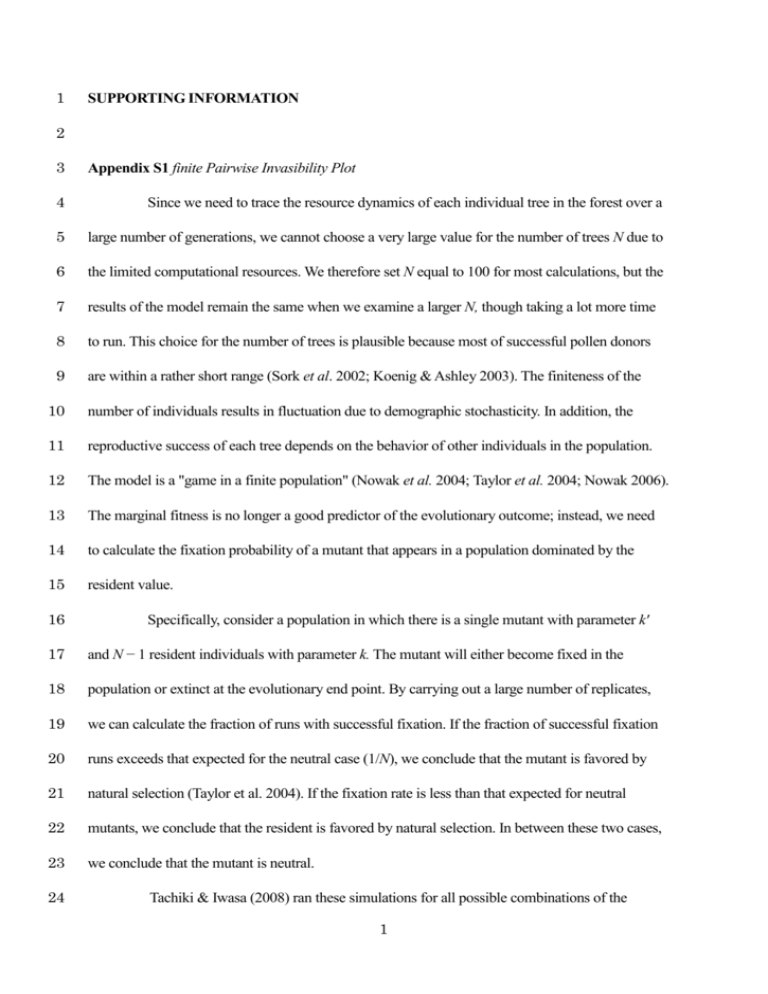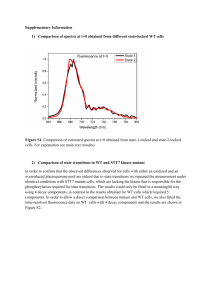JEC_1729_sm_AppsS1-2
advertisement

1 SUPPORTING INFORMATION 2 3 Appendix S1 finite Pairwise Invasibility Plot 4 Since we need to trace the resource dynamics of each individual tree in the forest over a 5 large number of generations, we cannot choose a very large value for the number of trees N due to 6 the limited computational resources. We therefore set N equal to 100 for most calculations, but the 7 results of the model remain the same when we examine a larger N, though taking a lot more time 8 to run. This choice for the number of trees is plausible because most of successful pollen donors 9 are within a rather short range (Sork et al. 2002; Koenig & Ashley 2003). The finiteness of the 10 number of individuals results in fluctuation due to demographic stochasticity. In addition, the 11 reproductive success of each tree depends on the behavior of other individuals in the population. 12 The model is a "game in a finite population" (Nowak et al. 2004; Taylor et al. 2004; Nowak 2006). 13 The marginal fitness is no longer a good predictor of the evolutionary outcome; instead, we need 14 to calculate the fixation probability of a mutant that appears in a population dominated by the 15 resident value. 16 Specifically, consider a population in which there is a single mutant with parameter k' 17 and N − 1 resident individuals with parameter k. The mutant will either become fixed in the 18 population or extinct at the evolutionary end point. By carrying out a large number of replicates, 19 we can calculate the fraction of runs with successful fixation. If the fraction of successful fixation 20 runs exceeds that expected for the neutral case (1/N), we conclude that the mutant is favored by 21 natural selection (Taylor et al. 2004). If the fixation rate is less than that expected for neutral 22 mutants, we conclude that the resident is favored by natural selection. In between these two cases, 23 we conclude that the mutant is neutral. 24 Tachiki & Iwasa (2008) ran these simulations for all possible combinations of the 1 25 resident’s k and the mutant’s k', and plotted the result on a two-dimensional square. The graph is a 26 finite-population version of the pairwise invasibility plot (PIP), and was called a "finite pairwise 27 invasibility plot" (fPIP). This method extends the PIP for an infinitely large population (Metz, 28 Nisbet & Geritz 1992; Kisdi & Meszéna, 1995; Geritz et al. 1997; Geritz, Meijden & Metz 1999) 29 to a finite population. 30 After1000 replicates for each pair of resident and mutant, ratio of fixation of mutant is 31 calculated. Figure S1 shows two fPIPs with different seedling survivorship. In each plot, 32 horizontal axis is the resident trait k, and vertical axis is the mutant trait k'. A point k, k' is 33 shaded black if the mutant has a fixation probability significantly higher than the neutral case. In 34 contrast, it is left white if the mutant has a fixation probability significantly lower than the neutral 35 case. Gray shading indicates no significant deviation from the neutral expectation. Note that the 36 area near the diagonal line (where the mutant k' is close to the resident k) is gray. 37 Using this graph, we can find evolutionary attractors to which the phenotype converges 38 as a result of evolution. Since mutants are similar to the parent in phenotype, we can focus on the 39 result near the diagonal line. If the area above the line is black, and if the area below the line is 40 white, the mutant with a greater phenotype (k' > k) has a higher fixation probability than the 41 resident and the mutant with a smaller phenotype (k' < k) cannot invade. In such a case, we 42 conclude that k should increase during evolution. 43 Figure S1a illustrates the case with small seedling survivorship ( ss 0.01). The 44 population starts with a value of k smaller than the evolutionary attractor, k* = 1.4. Mutants with k' 45 a little larger than the resident k have a fixation probability greater than that of the neutral case 46 (indicated in black). They can invade and subsequently replace the resident, and the value of k of 47 the population approaches k*. In contrast, if the resident population has k greater than k*, a mutant 48 with k' a little lower than k can invade and take over the population. As a result, the population 2 49 mean k moves toward k*. k* is an evolutionary attractor because a population with different initial 50 k gradually evolves toward k*. We expect that in the long run, k will converge to k * 1.4 , 51 although the stochasticity may occasionally result in fixation of a mutant that is not favored by 52 natural selection. 53 Figure S1b shows the fPIP for a higher survivorship of seedlings ( ss 0.5). For a wide 54 range of initial values of k, the population evolves to the same end point as that obtained by direct 55 simulation of evolutionary trajectories (Fig. 2). 56 The comparison of Figs. S1a and b again shows that the evolutionary outcome of k 57 increases with seedling survivorship. Moreover, the neutral region tends to become wider as 58 seedling survivorship increases. The width of the neutral range has an order of magnitude similar 59 to the standard deviation of k, shown in Fig. 2. 3 60 61 Fig. S1 Finite pairwise invasibility plots for different values of seedling survivorship ss . (a) 62 ss 0.01, (b) ss 0.5. In each panel, the vertical axis represents the resource depletion 63 coefficient k’ of a mutant, and the horizontal axis represents the resident k in the range 0 k 10 . 64 The black region indicates that the mutant has a fixation probability significantly higher than the 65 neutral expectation judged by 1000 replicate simulations (P < 0.01). In the white region, the 66 mutant has a significantly lower fixation probability than neutrality (P < 0.01). In the gray region, 67 the mutant has a fixation probability not distinguishable from the expectation of the neutral case. 68 Other parameter values are N = 100, = 0.04, = 10, and β = 2. 4 69 Appendix S2 Synchronization index 70 In this paper perfect synchronization of seed production never occur, because some 71 fraction of trees are immature, and even in mature trees, some have to take several years to 72 synchronize. 73 To quantify the degree of synchronization, we defined the following quantity named the 74 “synchronization index” (Satake & Iwasa 2002; Uriu, Morishita & Iwasa 2010): 75 IS 76 where i t is the time series of the seed production of i-th site, t is the average of i t 77 over all trees, Vart t is the temporal variance of the time series t , Vari i t is the 78 79 Vart t Vart t , Vartotal Vart t Mean t Vari i t between-tree variance at time t, and Mean t Vari i t is the temporal average of Vari i t . Consider the forest in which the trees are strongly synchronized in reproduction, but the 80 engaging I year-to-year fluctuation of the reproductive level is large, as is the case in forest 81 masting. The within-year variance, Vari i t is small but between-year variance, Vart t 82 is large. In this case IS becomes large ( 1). In contrast, in a desynchronized forest, the mean 83 does not change between yeas, and the forest always includes some reproductive level of forest 84 trees reproducing little, with their fractions unchanged. In such forest, the within-year variance is 85 large, but the between-year variance is small. As a result, IS becomes small ( 0 ). 86 87 References 88 Geritz, S. A. H., Metz, J. A. J., Kisdi, É. & Meszéna, G. (1997) The dynamics of adaptation and 89 90 evolutionary branching. Physical Review Letters, 78, 2024–2027. Geritz, S. A. H., Meijden, E. V. D. & Metz, J. A. J. (1999) Evolutionary dynamics of seed size and 91 seedling competitive ability. Theoretical Population Biology, 55, 324–343. 92 Kisdi, É. & Meszéna, G. (1995) Life histories with lottery competition in a stochastic 5 93 94 95 96 97 98 99 100 101 102 environment: ESSs which do not prevail. Theoretical Population Biology, 47, 191–211. Koenig, W.D. & Ashley, M.V. (2003) Is pollen limited? The answer is blowin' in the wind. Trends in Ecology and Evolution, 18, 157-159. Metz, J. A. J., Nisbet, R. M. & Geritz, S. A. H. (1992) How should we define ‘fitness’ for general ecological scenarios? Trends in Ecology and Evolution, 7, 198–202. Nowak, M.A. (2006) Evolutionary dynamics: Exploring the equations of life. Harvard University Press, Cambridge, MA. Nowak, M. A., Sasaki, A., Taylor, C. & Fudenberg, D. (2004) Emergence of cooperation and evolutionary stability in finite populations. Nature, 428, 646–650. Satake, A. & Iwasa, Y. (2002) The synchronized and intermittent reproduction of forest trees is 103 mediated by the Moran effect, only in association with pollen coupling. Journal of Ecology, 104 90, 830–838. 105 Sork, V.L., Davis, F.W., Smouse, P. E., Apsit, V.J., Dyer, R.J., Fernandez, J.F. & Kuhn, B. (2002) 106 Pollen movement in declining populations of California Valley oak, Quercus lobata: where 107 have all the fathers gone? Molecular Ecology, 11, 1657-1668. 108 109 110 111 112 Tachiki, Y. & Iwasa, Y. (2008) Role of gap dynamics in the evolution of masting of trees. Evolutionary Ecology Research, 10, 893–905. Taylor, C., Fudenberg, D., Sasaki, A. & Nowak, M. A. (2004) Evolutionary game dynamics in finite populations. Bulletin of Mathematical Biology, 66, 1621–1644. Uriu, K., Morishita, Y. & Iwasa, Y. (2010) Random cell movement promotes synchronization of 113 the segmentation clock. Proceedigs of the National Academy of Sciences of the United States 114 of America, 107, 4979-4984. 6








